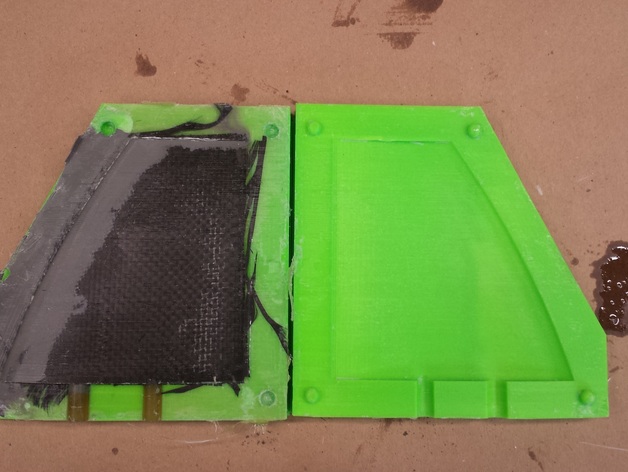
NACA Rocket Fin - High Powered Rocketry
thingiverse
A rocket fin design based on the NACA m2-il profile. Attached are the design files for the fin, a mold for casting the fins, and a jig to mount the fins to a 3 inch rocket body tube. This is the basic finset for a high powered amateur rocket using an M2020 motor that simulates to 35,000 feet altitude with a maximum velocity of mach 2.5. The model of the fin was derived directly from the NACA database and this particular profile was chosen for it's very good lift characteristics at high angles of attack in the subsonic region and low drag through transonic and supersonic regions. The fin model was used to create a two part mold which is used for an 18 layer Carbon Fiber and Fiberglass fin layup using an epoxy resin. (the mold must be carefully waxed and prepared with PVA to avoid bonding). Pictures of the fin coming out of the mold and trimmed are attached. In addition, a jig to hold the forward and aft portions of the fin for exact alignment is included. The jig fits the final molded fin perfectly and holds it orthogonal to the body tube and in perfect forward/aft alignment. The jig can also be used with 5/16" dowel to align mounting holes for an electronics bay, based on 3 #8 screws around the rocket body. Subsequent development includes printed assemblies for electronics (altimeters, timers, and GPS transmitters). Jigs and alignment fixtures are build with 3 shells for stability and strength. The mold was printed with a 0 and 90 degree orthogonal fill for maximum clamping strength without warping under pressure. Electronic bay components are aligned with the direction of thrust and use a 30% fill to withstand 27G upon takeoff. Print Settings Printer: Flashforge Creator Pro Rafts: No Supports: Yes Resolution: .14 for mold; .20 for jigs Infill: 30% Notes: The mold print includes both halves of the full mold attached back to back. The 1mm flange needs to be removed before using the mold, which aligns using the pins on the top half. The fin itself can be printed directly and then laminated with fiberglass or carbon fiber, but an epoxy resin should be used after heat treating the ABS surface. This would be suitable for flights below mach 1.5 due to leading edge heating. Such a fin would need several lamination layers and the designer needs to be careful to conform to the airfoil profile as closely as possible. Post-Printing Fin lamination Because the fin profile has a definite contour and different in thickness from leading to trailing edge the fiberglass/carbon fiber layup requires different shapes for each lamination layer. The 3D model was sectioned every 1mm to get a shape of the fin at that point. FG and CF were then cut to these template shapes along with a fiberglass matte to fill any voids. FG and CF layers were alternated for strength with sections added in to fill the void from bottom to top of each half of the fin. The mold is then clamped with excess resin being pushed out the vent holes (which should be positioned vertically). Each laminated fin came out of the mold with exactly the same dimensions, and each weigh 1.5 ounces with extreme stiffness. Can't wait to fly these on the rocket next month... How I Designed This Mold construction After choosing the airfoil, I downloaded the SVG profile. Using 123D and the points in the SVG profile, I created a spline sketch corresponding to the smoothed profile (smoothing the profile is very important). The sketch was then extruded to a basic shape, a copy was scaled for the fin tip, both were aligned and the fin was created by lofting through an intermediate profile. A straight swept fin can be done by lofting from the base to tip profiles. The mold was created by aligning two intersecting blocks with the center of the fin, subtracting the fin from the blocks, and then adding in alignment pins and rearranging back to back for printing. The corners of the mold lifted slightly during printing and an additional structure may be required to hold it down completely. The slight lifting I had did not change the profile.
With this file you will be able to print NACA Rocket Fin - High Powered Rocketry with your 3D printer. Click on the button and save the file on your computer to work, edit or customize your design. You can also find more 3D designs for printers on NACA Rocket Fin - High Powered Rocketry.
